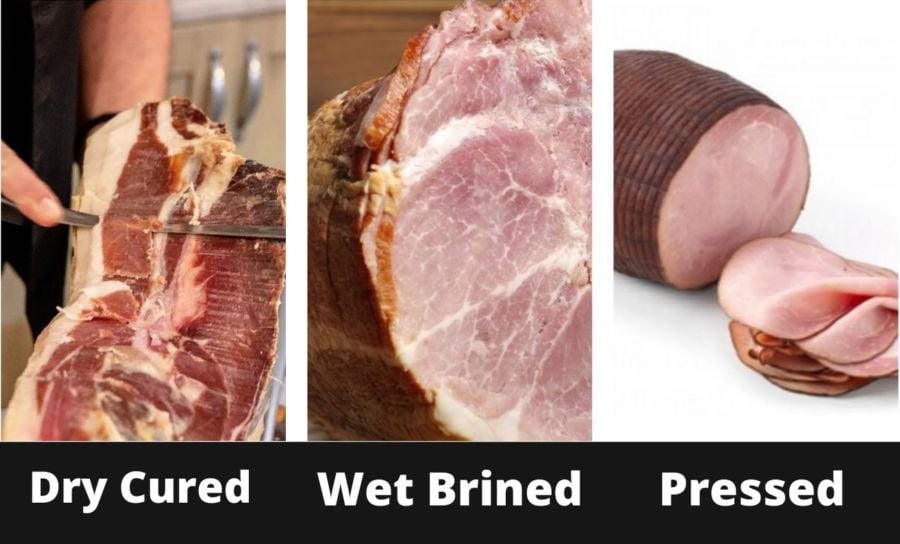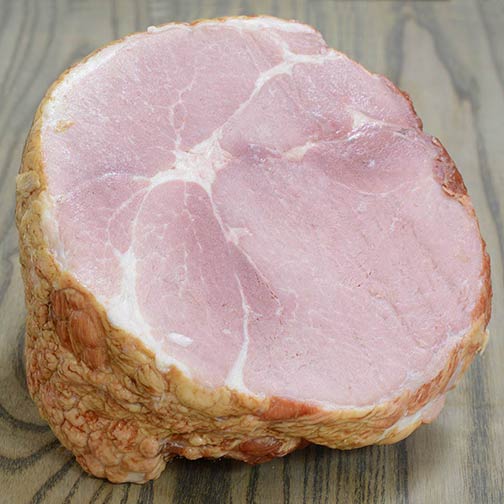The question is – how to avoid the ham being too salty; because after brine curing or wet brining the ham you want the result to be perfect. Buying a big chunk of ham or using a precious piece from a pig you’ve reared – it’s a beautiful thing!
It should not be too salty to be enjoyed.
This blog eatcuredmeat.com is all about making and eating cured meat, and over the years I’ve written a ton about how to brine( also called pickling) the ham.
All hams taste differently – confused? – but using this method below you are guaranteed to not get an overly salty ham.
Using an equilibrium wet brine or pickle with 1-2% salt concentration will not let the ham get too much salt to inhibit it. A brine injector needle will make sure the cure in the ham is properly dispersed.
Specifically, this is for when you are cooking the ham with or without smoke. Only for a dried ham that is preserved and has weight loss, you would need a much higher salt concentration.

We are talking mainly about wet brined and pressed not dry curing (wet vs dry curing article I wrote) which is drying without cooking (which a lot of this site is about though!).
The equilibrium brine calculation (calculation link for bacon/ham) is a percentage of salt to the total weight of the meat plus the water.
I know this sounds complicated so I created an equilibrium curing calculator – this tool is used to work out how much salt to use.
10lb / 5kg Ham = 5000g
1.5% salt
0.015 x (5,000+4000) = 135 grams of salt in 4 Liters of Water (use metric it’s way easier to calculate)
note. 4000ml of water = 4000 grams weight
Then the question is, how long to leave it in the brine. I would always advise getting a meat injection syringe. An injector means you are going to force that brine into the meat, otherwise, you have to wait for some time for the brine to penetrate.
Without this injector, it only affects the very outside of the meat.
Guide to The Perfect Salt-Cured Ham: To get that perfect salt-cured ham, there is one trick I have found that works. Well, let’s talk about two tricks.
How to Cure Ham So it’s Not Too Salty
Details about:
1) Equilibrium Wet Brining
2) Meat Syringe Injection
Equilibrium Wet Brining

It’s the key, because you end up choosing the level of saltiness, but at the same time, you can perform a light cure on the ham.
Equilibrium wet brining takes time, about one week per 1-inch thickness of meat (most pork hams are 3-10 inches, I guess).
What is achieved here is the right amount of salt to season the meat, and also allowing the salt to bind to the meat muscles inside.
Therefore, the water-binding holds the moisture in, so you have a much more juicy moist ham as an end-product. It really is about holding the moisture on the surface, so that when it cooks, it won’t dry out on the outside.
Meat Syringe Injection
This is especially important: for a cut of pork with a bone in it, and using a meat syringe, the salt is binding throughout the meat with these holes.
I also use it with boneless hams.
Water-binding will occur so that the moisture in the meat is ‘held’ in by the salt.
Most meat like pork is made up of around 60-70% water (like our bodies actually). The outcome of the water binding is a juicy/moist cooked ham!
After injecting your pork with equilibrium wet curing and a week in the fridge, you’re ready for the next step, which is forming the pellicle before smoking (if you are smoking, or just cook it in the oven).
If you’re not smoking and indirectly cooking the meat at the same time, then you don’t have to worry about the pellicle, it just means that the smoked vapor around the meat when it’s cooking adheres to the meat better = meaning more smoking flavor.
If you want to read about pellicle formation I wrote all about it here.
Why Wet Brining Ham is Better Than Dry Curing
If you’re using a wet brining/pickling type method, you’re locking the moisture of the meat.
As mentioned above, meat is 70% water and generally 20% protein.
Dry curing ham with a 1% equilibrium cure will mean the salt is drawn into the meat and held near the surface.
It won’t go deep like using a meat injection syringe for extra juiciness. But it does hold some moisture on the surface of the meat whilst cooking.
Why is Ham too Salty?
Saturation brining is about the time in the cure, the ‘degree’ of the brine represents the higher levels of salt diluted in it.
I want to touch on this since it’s the most common form of ‘brining’ meat. In essence, it’s placing meat in a saltwater solution for a set amount of time.
Here is a link to a table highlighting some of the commercial wet brine (saturation) levels. This is not the target area of the topic but I thought I would put it in here for anyone interested.
The oBé (oBaumé) scale was devised to correlate to the percentage concentration (% w/w) of a brine solution (salt in water).
http://www.monashscientific.com.au/Baume.htm
Using this traditional method of brining, you end up guessing the amount of salt penetration happening because there are other factors at hand.
Such as:
- time in brine
- fat to meat ratio
- the sinew
- muscle structure
- the temperature of the water
- amount of salt
I’ve done seafish for 12 minutes in an 80-degree brine, the fillets were only about 1/2 inch thick. It took about 40 minutes to dilute a rather large amount of salt!
As you can imagine all of these factors will vary the result – just look at the piece of pork that you’re using there will be variations each time. Hence Equilibrium Curing and Brining is the winner!
Why is Sugar Added to a Ham
I used to think sugar had some preserving effect a few decades ago when I started my meat curing adventure.
Sugar doesn’t have any preservation effect on the meat. It’s commonly used in brine recipes. I use it quite often to add a bit more flavor.
Just like apples or pineapple, sugar is a natural companion to pork and enhances the flavor. I find, sometimes, it’s gone a little overboard with the amount of sugar that is put into ham or bacon but that’s just my personal opinion. In terms of equilibrium brine percentage, I would use a maximum of 0.5% sugar in most of my curing/brining.
Why Cure a Ham with Salt
The main benefit when cooking/smoking ham is to get that salt brine in to hold in the moisture.
I do this by brining wild turkey (that I hunt ) which needs that moisture.
Without fat to render down and create a more juicy type of meat – brining is an excellent way of keeping things juicy for lean game meat.
The key again, if you’re cooking or hot smoking until it’s cooked, is to have a level of salt penetration that holds the moisture in during the cooking process.
Should I Soak a Ham Before Cooking?
If the ham is too salty, soaking in tap water for 30-60 minutes may get rid of some of the salt from the meat.
Then cut a piece off and fry it up to test the salt level. I’ve also done this with salmon after I have traditionally salt-cured it (not equilibrium-cured/brined) to make something like gravlax. Salmon is thinner meat that’s not as dense, the salt leaches out faster.

Tom Mueller
For decades, immersed in studying, working, learning, and teaching the craft of meat curing, sharing the passion and showcasing the world of charcuterie and smoked meat. Read More
